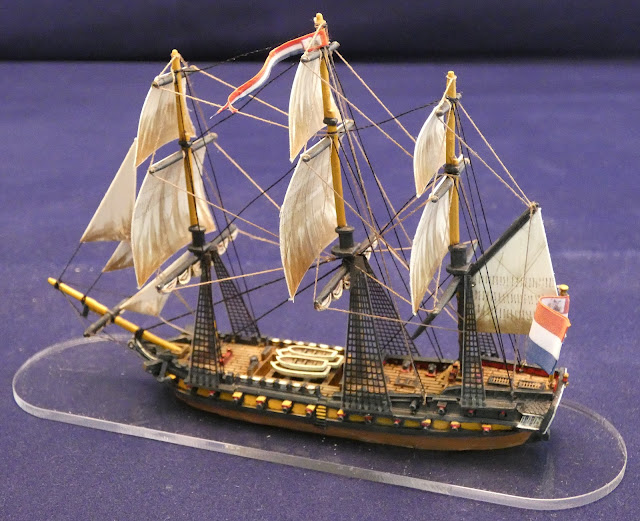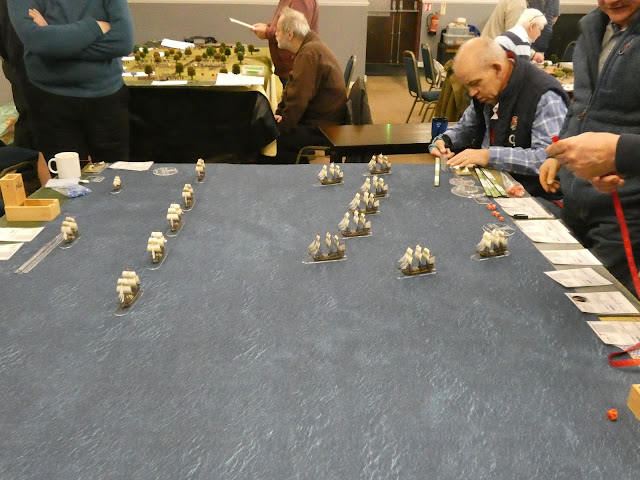Lots of activity in JJ's Shipyard this last couple of weeks as I worked to complete the Batavian battle line and the last five ships needed before moving on to the next stage of the Camperdown collection.
 |
| JJ's Wargames - All at Sea, Battle of Camperdown, Project Build, Part Six |
If you missed the last group of additions, I've linked them above where you can also find the links to the other models completed so far since October 2023.
 |
| The latest additions to my Batavian battle line, from left to right, Hercules 64-guns, Admiraal Tjerk Hiddes De Vries 68-guns and the razee Mars 44-guns. |
The planner below indicates progress too date with the addition of these next three models, leaving just the fourth-rate Beschermer 56-guns and the third-rate Gelijkheid 68-guns to go.
 |
| A satisfying look to my project planner with just two more ships to do for the Batavian battle line. |
Once the last two line of battle Batavian ships are done, my plan is to finish off the British battle line with work on Admiral Duncan's Windward Division, and then move on to finishing off the light forces of both fleets.
So without further ado I'd like to showcase the three latest additions to my Camperdown collection and a look at the history of these ships.
Mars
Mars was a 44-gun fifth-rate razee originally designed and built as a third-rate 68-gun ship of the line, named Zevenwolden and laid down in 1783 in the Harlingen-Friesland shipyard, launching on the following year, later refitting as a razee in 1795 and renamed Mars.
Her general characteristics were:
Tons burthen 684 tons (bm)
Length of gundeck 156 feet
Beam 43 feet, 7 inches
Depth of hold 17 feet, 7 inches
Her armament consisted of:
Gundeck: 26 x 32-pounder long guns
Quarterdeck & Forecastle: 18 x 18-pounders long guns
Not much seems to be recorded about the Mars prior to or after her conversion to a razee and likewise her involvement in the Battle of Camperdown is similarly scant on content.
Under the command of Kapitein ter Zee D. H. Kolf, she would appear to have made little impact in the battle, being part of the centre that escaped the brunt of the initial British attacks and together with the Leijden and Brutus seemed to have soon determined discretion over valour being the preferable option, escaping into the shallower waters, suffering the loss of her mizzen mast but only one killed and fourteen wounded.
She would suffer the fate of several of the other escapees from Camperdown two years later on the 30th August 1799 when she surrendered as part of a Dutch Squadron of eight ships, three frigates and one sloop to the British fleet of seventeen ships under Vice-Admiral Andrew Mitchell during the Vlieter Incident.
Admiraal Tjerk Hiddes De Vries
Admiraal Tjerk Hiddes De Vries was a 68-gun third-rate ship of the line, laid down on the 26th January 1782 in the Harlingen-Friesland shipyard and launching on 12th November 1782.
 |
| The Admiraal Tjerk Hiddes De Vries portrayed in a 1797 painting of the Battle of Camperdown by Martinus Schouman |
Her general characteristics were:
Tons burthen 1,300 tons (bm)
Length of gundeck 157 feet, 5 inches
Beam 44 feet, 8.5 inches
Depth of hold 16 feet, 2.5 inches
Her armament consisted of:
Gundeck: 26 x 32-pounder long guns
Upper Gundeck: 26 x 18-pounder long guns
Quarterdeck & Forecastle: 16 x 8-pounders long guns
The De Vries sailed to the Mediterranean in 1783 under the command of Kapitein Van der Beets, and on her return home was put in ordinary until recommissioning in 1795, joining the Republican Batavian fleet.
At the Battle of Camperdown she was under the command of Kapitein ter Zee J. B. Zegers, becoming heavily embroiled in the battle around the Batavian flagship Vrijheid, engaging the British flagship Venerable on her approach and then combining her fire with the Vrijheid to badly damage the 64-gun Ardent, which would see the death of her captain and 148 casualties including 41 killed in the exchange of fire.
Notably this action appears in the fiction of Patrick O'Brian's 'Desolation Island' when Captain Jack Aubrey recounts his memories of being below decks as a young midshipman aboard the Ardent, and the wrecked ship and casualties that resulted from this encounter.
The arrival of the two other British van 74's, Bedford and Triumph soon helped to relieve the pressure on the Venerable and Ardent with Bedford singling out the De Vries, and later joined by the Triumph after she had forced the Wassenaer to strike at about 14.00.
 |
| The battle at its close at 15.00 with the Admiraal Tjerk Hiddes De Vries now struck and under the watchful eyes of the Bedford and Isis. |
However the De Vries put up a hard fight, reportedly suffering heavy damage to her hull and becoming dismasted before finally striking at 15.00. Her casualties are unrecorded.
The Venerable, Ardent, Bedford and Triumph suffered 380 casualties between them including 115 killed, easily the most badly damaged ships among the British fleet alongside HMS Monarch (36 killed/ 100 wounded) leading the Leeward Division, indicating the severity of the fight put up by the Vrijheid and De Vries, Hercules and Gelijkheid.
Hercules
Hercules was a 64-gun third-rate ship of the line, and launched on 12th April 1781 at the Dordrecht Shipyard.
The Hercules is perhaps the most iconic ship from the Battle of Camperdown, appearing as she does in just about every painting and illustration of the battle, on fire, as her crew desperately fought a blaze caused by exchanges of gunfire with the British 74's Bedford and Triumph.
 |
| A contemporary impression of the Hercules after her capture at Camperdown |
For such an iconic ship I decided to let loose with a bit of artistic licence in the way I wanted her represented in my Batavian battle line, giving her a suitably Herculean figurehead rather than a more usual Dutch lion.
Her general characteristics were:
Tons burthen ? (bm)
Length of gundeck 155 feet, 1 inch
Beam 42 feet, 9 inches
Depth of hold 18 feet, 6 inches
Her armament consisted of:
Gundeck: 26 x 24-pounder long guns
Upper Gundeck: 26 x 18-pounder long guns
Quarterdeck & Forecastle: 12 x 8-pounders long guns
Hercules was the third ship in the Batavian line, part of the Blue Squadron along with the squadron flagship Brutus, the Admiraal Tjerk Hiddes De Vries astern and ahead, the fourth-rate Beschermer and third-rate Gelijkheid.
As with the Mars, information about the Hercules before Camperdown is scarce, but her performance in the battle was much more notable, being, like the Admiraal Tjerk Hiddes De Vries, heavily engaged in the fight with Admiral Duncan's Windward Division that climaxed with the battle around the Batavian flagship Vrijheid.
In the next post, I'll take a look at the last two Batavian ships at the lead of their line of battle, the Beschermer and Gelijkheid.
More anon
JJ












































